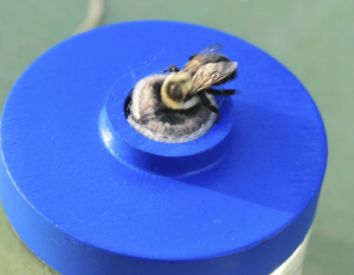Estimating pollination success with novel artificial flowers: Effects of nectar concentration
DOI:
https://doi.org/10.26786/1920-7603(2012)14Abstract
We developed novel artificial flowers that dispense and receive powdered food dyes as pollen analogues while their nectar is replenished by capillary action. Dye receipt, which can be measured colourimetrically, is a direct surrogate for pollen receipt or female reproductive success, but can also serve to compare pollen donation (male reproductive success) from flowers with different colours of dye. By allowing captive bumble bee colonies to visit large arrays of such flowers, we investigated whether total dye receipt depended on the sugar concentration of a flower’s nectar. Estimating pollen transfer, rather than simply visitation rate, is appropriate for this question because flowers with more concentrated nectar might accrue more pollen not only through higher visitation rates but also through longer visits that transfer more pollen per visit. Flowers with richer nectar did receive more dye regardless of their spatial arrangement, but the effect was greatest when rich and poor flowers were segregated in large blocks, as opposed to being intermingled.
Downloads
Published
2012-10-31
How to Cite
Thomson, J. D., Ogilvie, J. E., Makino, T. T., Arisz, A., Raju, S., Rojas-Luengas, V., & Tan, M. (2012). Estimating pollination success with novel artificial flowers: Effects of nectar concentration. Journal of Pollination Ecology, 9, 108–114. https://doi.org/10.26786/1920-7603(2012)14
Issue
Section
Notes on Methodology
License
Copyright (c) 2012 James D. Thomson, Jane E. Ogilvie, Takashi T. Makino, Angela Arisz, Sneha Raju, Vanessa Rojas-Luengas, Marcus Tan

This work is licensed under a Creative Commons Attribution 4.0 International License.











